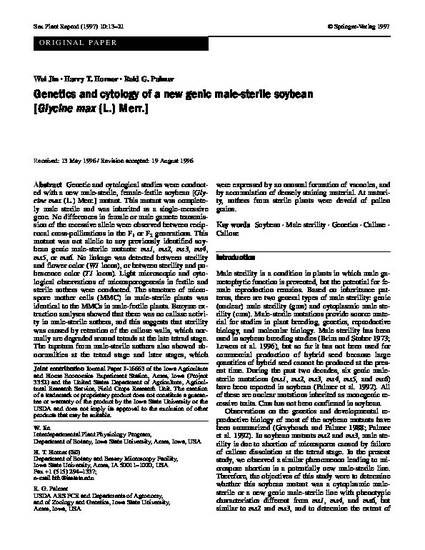
Article
Genetics and cytology of a new genic male-sterile soybean [Glycine max (L.) Merr.]
Sexual Plant Reproduction
Document Type
Article
Disciplines
Publication Version
Published Version
Publication Date
2-1-1997
DOI
10.1007/s004970050062
Abstract
Genetic and cytological studies were conducted with a new male-sterile, female-fertile soybean [Glycine max (L.) Merr.] mutant. This mutant was completely male sterile and was inherited as a single-recessive gene. No differences in female or male gamete transmission of the recessive allele were observed between reciprocal cross-pollinations in the F1 or F2 generations. This mutant was not allelic to any previously identified soybean genic male-sterile mutants: ms1, ms2, ms3, ms4, ms5, or ms6. No linkage was detected between sterility and flower color (W1 locus), or between sterility and pubescence color (T1 locus). Light microscopic and cytological observations of microsporogenesis in fertile and sterile anthers were conducted. The structure of microspore mother cells (MMC) in male-sterile plants was identical to the MMCs in male-fertile plants. Enzyme extraction analyses showed that there was no callase activity in male-sterile anthers, and this suggests that sterility was caused by retention of the callose walls, which normally are degraded around tetrads at the late tetrad stage. The tapetum from male-sterile anthers also showed abnormalities at the tetrad stage and later stages, which were expressed by an unusual formation of vacuoles, and by accumulation of densely staining material. At maturity, anthers from sterile plants were devoid of pollen grains.
Rights
Works produced by employees of the U.S. Government as part of their official duties are not copyrighted within the U.S. The content of this document is not copyrighted.
Language
en
File Format
application/pdf
Citation Information
Wei Jin, Harry T. Horner and Reid G. Palmer. "Genetics and cytology of a new genic male-sterile soybean [Glycine max (L.) Merr.]" Sexual Plant Reproduction Vol. 10 Iss. 1 (1997) p. 13 - 21 Available at: http://works.bepress.com/harry-horner/28/

This article is from Sexual Plant Reproduction 10 (1997): 13, doi: 10.1007/s004970050062.